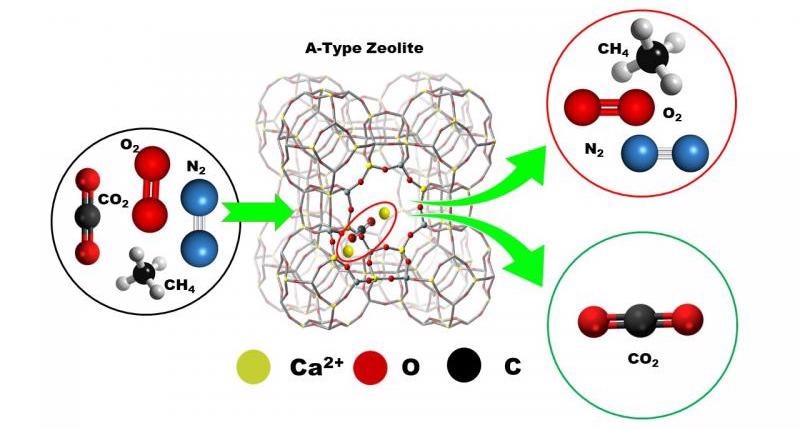May 7 2021
The fact that carbon dioxide is the largest contributor to climate change and mainly emerges from the burning of fossil fuels is common knowledge.
 A New Avenue in Ca2+ Ion-Exchanged A-Type Zeolite Chemistry. Image Credit: 2021 Okayama University-InorgChem.
A New Avenue in Ca2+ Ion-Exchanged A-Type Zeolite Chemistry. Image Credit: 2021 Okayama University-InorgChem.
All over the world, there are measures in progress to end the reliance on fossil fuels as energy sources. But the potential of green energy still lies in the future. A new study examined whether something could be done to decrease the CO2 concentrations in the air.
Indeed, it would be great if the CO2 present in air could just be adsorbed. This is exactly what the capture of CO2 under ambient conditions, or direct air capture (DAC), intends to do. But until now, researchers have not developed such a material that can adsorb CO2 efficiently under DAC conditions.
It is well known that CO2 is acidic in nature. Therefore, materials with basic nature are generally utilized as adsorbents for CO2. However, that often leads to corrosion of the system and is also not suitable for recycling the adsorbed CO2.
Yasushige Kuroda, Professor, Okayama University
Kuroda carried out a study on surface chemistry.
In this context, a recent study by researchers from Okayama University and Japan Synchrotron Radiation Research Institute (JASRI), reported in the Journal of Materials Chemistry A and guided by Professor Kuroda, examined the adsorption properties of a material that has until now continued to be an “underdog”: zeolites (minerals consisting primarily silicon oxides and aluminum).
Zeolite materials have received little attention as adsorbents owing to their low CO2 adsorption capacity at room temperature and in the lower pressure adsorption region, as well as their poor selectivity over nitrogen.
Yasushige Kuroda, Professor, Okayama University
As part of their research, Professor Kuroda and his group developed an ion-exchanging technique of zeolite along with alkaline-earth ions and achieved an exceptionally high CO2 adsorption under ambient conditions.
Particularly, the researchers selected an A-type zeolite (silicon/aluminum ratio of 1) due to its suitable pore size for adsorbing CO2, while the alkaline-earth ion-exchange rendered a huge electric field strength that, purportedly, served as a driving force for the adsorption.
A doubly charged calcium ion (Ca2+) was selected by the researchers as the exchange ion as it enabled the highest amount of adsorption. Indeed, the adsorbed volume observed was the highest amount of CO2 to have ever been adsorbed by any zeolite system, exceeding that for other materials under analogous situations.
The researchers analyzed the basic adsorption mechanism by performing far-infrared (far-IR) measurements and backed them up with the help of density functional theory (DFT) calculations.
The far-IR spectra, which detected the vibrational modes caused by Ca2+-zeolite vibration, revealed a clear shift toward longer wavelengths after CO2 adsorption, a feature which could not be identified by researchers in other samples, for example, Na-ion exchanged A-type zeolite. Moreover, they confirmed their observation with a model that exhibited good agreement with DFT calculations.
Furthermore, the researchers could entirely desorb the adsorbed CO2 and retrieve the original sample and its particular adsorption properties. Besides, the sample exhibited excellent selective adsorption of CO2 from other gases once the researchers analyzed the separation of CO2 with the help of a model gas that mimicked ambient air in its composition.
Therefore, the results demonstrate zeolites as efficient adsorbents of CO2 under ambient conditions—a breakthrough that was earlier believed to be impossible with such systems.
Our work can open doors to potentially novel applications of zeolites, such as in the cleaning of air inside semi-closed spaces including space shuttles, submarines, and concert halls, and as an adsorbent material in the anesthetic process.
Yasushige Kuroda, Professor, Okayama University
What is certain is that chemists will never consider zeolite as the same material they understood previously.
Journal Reference:
Oda, A., et al. (2021) Unprecedented CO2 adsorption behavior by 5A-type zeolite discovered in lower pressure region and at 300 K. Journal of Materials Chemistry A. doi.org/10.1039/D0TA09944A.